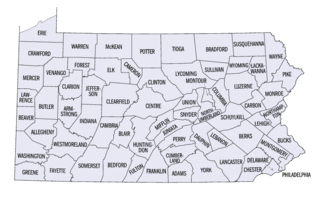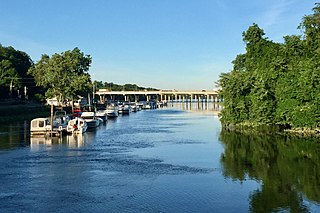Related Research Articles

Buildings, sites, districts, and objects in Delaware listed on the National Register of Historic Places:

This is a list of properties and districts listed on the National Register of Historic Places in Pennsylvania. As of 2015, there are over 3,000 listed sites in Pennsylvania. All 67 counties in Pennsylvania have listings on the National Register.
List of the National Register of Historic Places listings in Kent County, Delaware
This National Park Service list is complete through NPS recent listings posted July 28, 2023.
This is a list of properties on the National Register of Historic Places in northern New Castle County, Delaware.

This is a list of the National Register of Historic Places listings in Henry County, Indiana.

The Book site is an archaeological site in Juniata County, Pennsylvania, United States. Consisting of the remnants of a burial mound and a prehistoric village, the site lies on both sides of Camp Resort Road in Beale Township, near the community of Beale.
The Ufferman Site is an archaeological site in the central part of the U.S. state of Ohio. Located north of the city of Delaware, it occupies approximately 2 acres (0.81 ha) of land near Delaware Lake on property near to the boundaries of Delaware State Park. It appears to have been the location of a village of the Cole culture, which inhabited the region during the later portion of the Woodland period. Ufferman lies only 0.6 kilometres (0.37 mi) south of the W.S. Cole Site, the type site for the culture, and approximately 23 kilometres (14 mi) north of the Highbank Park Works, which are believed to have been built by peoples of the Cole culture.
Salisbury Farm, also known as the Salisbury Site, is a 5-acre (2.0 ha) prehistoric and historic archaeological site located in the Bridgeport section of Logan Township in Gloucester County, New Jersey, United States. Located in the vicinity of Raccoon Creek and the Delaware River, it was the site of both Native American habitation and of early colonial settlement in the mid-17th century. The site, first investigated under the auspices of the Works Progress Administration in 1937, was added to the National Register of Historic Places on March 7, 1979. In 1939, the State Archaeologist Dorothy Cross may have found two possible earthfast buildings from the 1670s to 1680s occupation of the Salisbury site.
The Carey Farm Site (7K-D-3) is a prehistoric Native American archaeological site in central Kent County, Delaware, near Dover. The site, located along the St. Jones River, encompasses what is believed to be a major seasonal base camp from the Woodland Period. Ceramics dating back to 200 CE have been found at the site.
The Byfield Historic District encompasses the remains of an early colonial community in eastern Kent County, in the U.S. state of Delaware. The district includes four separate archaeological sites, each of which have been associated with early English settlers of the area. The site designated K-929 is the location of a brick kiln, which documentary evidence suggests was associated with Daniel Jones, the first settler in the area. K-917 is speculated to be associated with William Rodney, who married Jones' daughter. K-916 is a site that may have been a slave residence, and K-890 is believed to be the site of one of the homes of Caesar Rodney, Sr., the father of Delaware Revolutionary War leader Caesar Rodney. The only 19th century structure in the district is the S. A. Sipple House.
The Hughes-Willis Site is a prehistoric Native American archaeological site in Kent County, Delaware. It is located in Dover, Delaware on the banks of the Little River, and was identified in 1971. The site contains evidence of occupation dating back 5,000 years, with its most significant occupational period being the Middle Woodland Period. Finds at the site include projectile points, and tools for cutting and scraping made of stone. The evidence suggests the site was occupied seasonally, probably sometime in the period between late fall and mid-winter.
St. Jones Neck is a geographic region of eastern central Kent County, Delaware, United States, with a rich prehistory and colonial history. Originally known just as Jones Neck, it is bounded on the west by the St. Jones River, on the north by Little Creek, and on the east by Delaware Bay. The area consists of low rolling hills that do not rise very much above sea level, interspersed with bodies of fresh and salt water. Streams are headed by marshes, and there are tidal marshlands along the bay. The neck has pockets of woodland which are concentrated near the freshwater marshes and tributaries. Land use in the neck is at present predominantly agricultural.
The Thompson's Loss and Gain Site is a colonial-era historic site near Rehoboth Beach in Sussex County, Delaware. It is an archaeological site encompassing a tenant farm that was in active use from about 1720 to 1780. The site includes the site of a house, root cellar, and well. It was listed on the National Register of Historic Places in 1978.
The Island Field Site (7K-F-17) is a major archaeological site in Kent County, Delaware, United States. The site is located in South Bowers, just south of the Murderkill River near where it empties into Delaware Bay. The site was a major prehistoric Native American village site, which was most notable for its cemetery. The site was first identified in the 1920s during road work, and was excavated in the 1950s-60s, after which the area was eventually built up to include a museum. In 1986 members of the local Nanticoke tribe protested the display and removal for research of burial remains at the site.
The Hell Island Site (7NC-F-7) is a prehistoric archaeological site located near Odessa, Delaware. The site is a type site for a class of ceramics found at other sites in the region. Artifacts recovered from the site during excavations in 1965 yielded then-distinctive tempered pottery with cordmarking on the interior and exterior, as well as evidence of occupation of the site from the Archaic to the Late Woodland Period.
The Dill Farm Site (7K-E-12) is a prehistoric archaeological site in Kent County, Delaware, near the town of Sandtown. The site located in a formerly swampy area, has yielded dates of 500 BC and 8000 BC. Carey Complex ceramics have also been found at the 55-acre (22 ha) site.
The Hughes Early Man Sites are a complex of prehistoric archaeological sites in central Kent County, Delaware, near the town of Felton. The complex includes six areas of concentrated finds located on well-drained knolls. Finds include a Clovis projectile point, a collection of notched projectile points, bifaces, and remnants of stone tool-making activities.
The Indian River Archeological Complex is a collection of archaeological sites near Millsboro, Delaware, encompassing what is the only known riverine settlement in Sussex County during the Middle Woodland Period. It consists of three separate sites, 7S-F-11, 7S-F-12, and 7S-F-13. These sites appear to have been semi-permanent seasonal settlements, occupied during the spring and fall, and abandoned for other hunting and fishing grounds in the summer and winter. Finds at each site include both worked stone artifacts including projectile points, as well as different types of ceramics. The combination of finds raises questions about the pattern of cultural migration in the area, which further investigation of the sites may shed light on. Of the three sites, two have been subjected to surface-level collection, and one, 7S-F-13, has been subjected to more intensive excavations.

The Crosswicks Creek Site III is a historical archaeological site in the vicinity of Bordentown in Burlington County and Hamilton Township in Mercer County, New Jersey. It encompasses the remains of Revolutionary War-era ships that were sunk in Crosswicks Creek in 1778. The site was listed on the National Register of Historic Places on November 26, 1990, for its significance in military and maritime history.
References
- 1 2 "National Register Information System". National Register of Historic Places . National Park Service. July 9, 2010.
- ↑ Custer, Jay (1984). Delaware Prehistoric Archaeology. University of Delaware Press. pp. 188–89. ISBN 9780874132335.